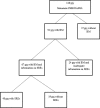Bone metastases and skeletal-related events in patients with malignant pheochromocytoma and sympathetic paraganglioma
- PMID: 23436918
- PMCID: PMC5393459
- DOI: 10.1210/jc.2012-4231
Bone metastases and skeletal-related events in patients with malignant pheochromocytoma and sympathetic paraganglioma
Abstract
Context: Bone metastases (BM) can cause severe pain, spinal cord compression, pathological fractures, and/or hypercalcemia. These skeletal-related events (SREs) may cause immobilization, loss of independence, poor quality of life, and reduced survival. There is limited information on the clinical effects of BM and SREs in patients with malignant pheochromocytoma or sympathetic paraganglioma (PHEO/sPGL).
Objectives: We studied the prevalence and clinical characteristics of BM and SREs in patients with PHEO/sPGL and investigated the risk factors for SRE development.
Design: Using a large institutional database, we conducted a retrospective study of 128 patients with malignant PHEO/sPGL at The University of Texas MD Anderson Cancer Center from 1967 through 2011.
Results: Of the patients, 91 (71%) had BM, and 57 of these (63%) developed metachronous BM at a median time of 3.4 years (range, 5 months to 23 years) after the primary tumor diagnosis. Metastatic disease was confined exclusively to the skeleton in 26 of 128 (20%) patients. Sufficient information to assess SRE occurrence was available for 67 patients, and 48 of 67 (72%) patients had at least 1 SRE. The median overall survival for the 128 patients was 12 years for patients with only BM, 7.5 years for patients with nonosseous metastases, and 5 years for patients with both BM and nonosseous metastases (log rank test P value = .005). We were unable to identify factors predictive of SRE development, but the occurrence of a first SRE was associated with the development of subsequent SREs in 48% of subjects. In responsive patients, the use of systemic therapy was associated with fewer SREs (P < .0001).
Conclusions: BM and SREs are frequent in patients with malignant PHEO/sPGL. SREs often develop shortly after the diagnosis of BM; severe pain is the most frequent SRE. These patients should be followed long-term by a multidisciplinary team to promptly identify the need for medical or surgical intervention.
Figures
References
-
- Bubendorf L , Schopfer A , Wagner U , et al. . Metastatic patterns of prostate cancer: an autopsy study of 1,589 patients. Hum Pathol. 2000;31:578–583. - PubMed
-
- Maldazys JD , deKernion JB. Prognostic factors in metastatic renal carcinoma. J Urol. 1986;136:376–379. - PubMed
-
- Schlumberger M , Tubiana M , De Vathaire F , et al. . Long-term results of treatment of 283 patients with lung and bone metastases from differentiated thyroid carcinoma. J Clin Endocrinol Metab. 1986;63:960–967. - PubMed
-
- Zuetenhorst JM , Hoefnageli CA , Boot H , Valdes Olmos RA , Taal BG. Evaluation of 111In-pentetreotide, 131I-MIBG and bone scintigraphy in the detection and clinical management of bone metastases in carcinoid disease. Nucl Med Commun. 2002;23:735–741. - PubMed
Publication types
MeSH terms
Grants and funding
LinkOut - more resources
Full Text Sources
Other Literature Sources
Medical



